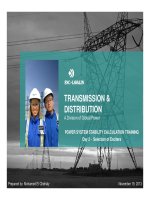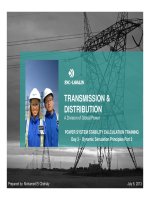Phần 19 KHÓA ĐÀO TẠO TÍNH TOÁN ỔN ĐỊNH VÀ ỨNG DỤNG TRÊN PHẦN MỀM PSSE CHO KỸ SƯ HỆ THỐNG ĐIỆN (Mô phỏng đường dây siêu cao áp HDVC trong tính toán ổn định động)
Bạn đang xem bản rút gọn của tài liệu. Xem và tải ngay bản đầy đủ của tài liệu tại đây (2.96 MB, 54 trang )
TRANSMISSION &
DISTRIBUTION
A Division of Global Power
POWER SYSTEM STABILITY CALCULATION TRAINING
D8
HVDC Si l ti P t 2
D
ay
8
-
HVDC
Si
mu
l
a
ti
on
P
ar
t
2
November 26, 2013Prepared by: Mohamed El Chehaly
eBook for You
OUTLINE
2
OUTLINE
• General Considerations
•
HVDC Dynamic Models
HVDC
Dynamic
Models
• Com
p
lete HVDC Model in D
y
namic Studies
py
eBook for You
3
GENERAL CONSIDERATIONS
GENERAL
CONSIDERATIONS
eBook for You
Introduction
4
GENERAL CONSIDERATIONS
Introduction
DC transmission behavior is dominated by
its controls
It is not practical to model the detailed
dynamics of the controls because the
bandwidth of these controls is far greater
than that of PSS®E
than
that
of
PSS®E
Each converter bridge is controlled by a
local feedback loop
local
feedback
loop
These local loops work independently to
maintain bridge current or voltage at
maintain
bridge
current
or
voltage
at
desired value
eBook for You
Introduction
5
GENERAL CONSIDERATIONS
Introduction
The desired values are provided by an
outer control loop that works in a
outer
control
loop
that
works
in
a
supervisory role and coordinates the
action of the several converter bridges
action
of
the
several
converter
bridges
and the AC power system
eBook for You
Behavior of the Brid
g
es and their Inner
6
GENERAL CONSIDERATIONS
g
Control Loops
A rectifier bridge may be regarded as an
adjustable voltage source forcing current
through transmission system resistance
di d t i tth t t
an
d
i
n
d
uc
t
ance aga
i
ns
t
th
e cons
t
an
t
voltage source of the inverter
eBook for You
Behavior of the Brid
g
es and their Inner
7
GENERAL CONSIDERATIONS
g
Control Loops
A simple current control: open-loop basis
with a gain equal to DC resistance
A step change in current is applied
eBook for You
Behavior of the Brid
g
es and their Inner
8
GENERAL CONSIDERATIONS
g
Control Loops
DC rectifier is a feedback loop controller
that adjusts firing delay to control the DC
current to a setpoint
A step change in current is applied
eBook for You
PSS®E Models and Control Loops
9
GENERAL CONSIDERATIONS
Several PSS®E models (CDC4T CDC6T )
PSS®E
Models
and
Control
Loops
Several
PSS®E
models
(CDC4T
,
CDC6T
…
)
treat DC converter pairs as if they move
instantaneousl
y
to their new o
p
eratin
g
y
pg
point when any of their input signals are
changed
HVDC dynamic models calculate the real
and reactive power loading of the
converters using steady-state converter
relationships
with transformer taps fixed
relationships
with
transformer
taps
fixed
eBook for You
PSS®E Models and Control Loops
10
GENERAL CONSIDERATIONS
Several models are
not concerned
with the
PSS®E
Models
and
Control
Loops
Several
models
are
not
concerned
with
the
internal dynamic behavior of converters
and DC lines
and
DC
lines
Pseudo steady
-
state
HVDC dynamic
Pseudo
steady
state
HVDC
dynamic
models are not able to directly represent
the mode of operation where the rectifier
firing angle is not at a limit and the
inverter margin angle is also not at a limit
t lli lt (CDC4T CDC6T )
or con
t
ro
lli
ng vo
lt
age
(CDC4T
,
CDC6T
…
)
eBook for You
PSS®E Models and Control Loops
11
GENERAL CONSIDERATIONS
HVDC models such as CDCVUP re
p
resent
PSS®E
Models
and
Control
Loops
p
the temporary dynamic condition when
neither converter is at a firing angle or
margin angle limit and both are fighting for
control of current
PSS®E l i l d d l (CASEA1 d
PSS®E
a
l
so
i
nc
l
u
d
e mo
d
e
l
s
(CASEA1
an
d
CDCRL) that represent some high-
frequency controller effects
and
L/R
frequency
controller
effects
and
L/R
dynamics of the DC transmission. These
m
ode
l
s
use
a
n in
te
rn
a
l in
teg
r
at
i
o
n
t
im
e
ode s use a te a teg at o t e
shorter than by other PSS®E models
eBook for You
Actions by the Controls
12
GENERAL CONSIDERATIONS
Three distinct t
yp
es of action b
y
the
Actions
by
the
Controls
yp y
controls
Normal regulation of DC converter operation to
maintain specified constant current or constant
power transfer with coordination of rectifier and
inverter current
setpoints
inverter
current
setpoints
Temporary overriding of DC converter normal
operating setpoints in response to disturbances of
AC t lt d i f lt
AC
sys
t
em vo
lt
ages
d
ur
i
ng
f
au
lt
s
Modulation of the DC power setpoint by a
supplementary control device
(assist in the
supplementary
control
device
(assist
in
the
damping of rotor angle swings)
eBook for You
Actions by the Controls
13
GENERAL CONSIDERATIONS
Normal re
g
ulation
Actions
by
the
Controls
g
With sufficient AC voltage for alpha control
eBook for You
Actions by the Controls
14
GENERAL CONSIDERATIONS
Normal re
g
ulation
Actions
by
the
Controls
g
With depressed AC voltage
eBook for You
Actions by the Controls
15
GENERAL CONSIDERATIONS
Response following disturbance
When AC or DC voltages reach abnormal levels
Actions
by
the
Controls
When
AC
or
DC
voltages
reach
abnormal
levels
that may cause commutation failures, excessive
currents or unacceptable harmonics
PSS®E DC models execute these overriding
control actions when positive sequence AC
voltages or DC voltages reach specified levels
voltages
or
DC
voltages
reach
specified
levels
The modeling of protective action is not possible
The protection of DC converter is dependent on
individual phase-to-ground and phase-to-phase voltage
wave forms and these are not available in PSS®E
The protection of each bridge is determined by the
internal details of firing controls with a low-frequency
band
eBook for You
Protective Actions
16
GENERAL CONSIDERATIONS
Block
Protective blocking is used to stop the flow of both
Protective
Actions
Protective
blocking
is
used
to
stop
the
flow
of
both
AC and DC current in order to limit the effect of the
fault
Rectifier usually blocked when an AC fault is
applied on the AC side of the rectifier
Thi i hi d b i l i th fi i
Thi
s
i
s ac
hi
eve
d
b
y s
i
mp
l
y remov
i
ng
th
e
fi
r
i
ng
pulses to all the valves in the converter
Blockin
g
can be simulated b
y
chan
g
in
g
the
gygg
appropriate ICON or by raising the blocking
voltage threshold to force a block
eBook for You
Protective Actions
17
GENERAL CONSIDERATIONS
Bypass
When fault signals of the inverter detect one of the
Protective
Actions
When
fault
signals
of
the
inverter
detect
one
of
the
following
Commutation failure
Undervoltage
Abnormal firing angle or misfire
Provides a DC short
circuit across the converter
Provides
a
DC
short
-
circuit
across
the
converter
bridge
Blocking four valves in the 6-pulse bridge and
firing the remaining two as a bypass pair
The DC side is shorted and the AC side is open
Th tifi ill ti t i l t l l l
Th
e rec
tifi
er w
ill
con
ti
nue
t
o c
i
rcu
l
a
t
e a
l
ow
l
eve
l
current
eBook for You
Protective Actions
18
GENERAL CONSIDERATIONS
Commutation failure
May occur following an AC system disturbance
Protective
Actions
May
occur
following
an
AC
system
disturbance
close to the inverter station
Probabilit
y
increased when volta
g
e on the AC side
yg
of the inverter is decreased by 0.1 p.u.
Repeated commutation failures can lead to
bl ki f th l
bl
oc
ki
ng o
f
th
e va
l
ves
Happen if the commutation of current from one
valve to another has not been com
p
leted before
p
the commutating voltage reverses across the
ongoing valve
Eti ti l i t ll
E
x
ti
nc
ti
on ang
l
e
i
s
t
oo sma
ll
eBook for You
Protective Actions
19
GENERAL CONSIDERATIONS
Commutation failure
Equivalent circuit for three
phase bridge converter
Protective
Actions
Equivalent
circuit
for
three
-
phase
bridge
converter
eBook for You
Protective Actions
20
GENERAL CONSIDERATIONS
Commutation failure
Due to voltage magnitude reduction
Protective
Actions
Due
to
voltage
magnitude
reduction
eBook for You
Protective Actions
21
GENERAL CONSIDERATIONS
Commutation failure
Due to voltage dip with backward phase
angle
Protective
Actions
Due
to
voltage
dip
with
backward
phase
-
angle
shift
eBook for You
Protective Actions
22
GENERAL CONSIDERATIONS
Commutation failure
Due to increased DC current
Protective
Actions
Due
to
increased
DC
current
eBook for You
Protective Actions
23
GENERAL CONSIDERATIONS
Commutation failure
Protective
Actions
eBook for You
24
HVDC DYNAMIC MODELS
HVDC
DYNAMIC
MODELS
eBook for You
Model CDC4
25
HVDC DYNAMIC MODELS
Model
CDC4
Ranges of alpha and gamma angles in
power flow and dynamics
eBook for You









